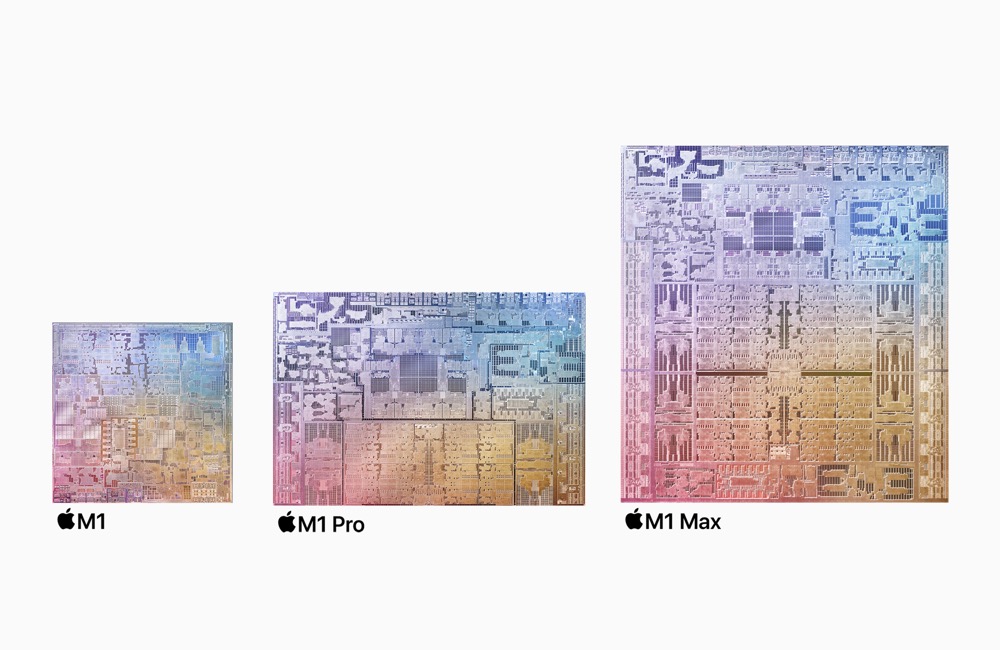Apple chips: it’s not just size, it’s the motion of the ocean

Three chips together: M1, M1 Pro, M1 Max
The betting is that Apple’s drive toward 3-nanometre processors begins in earnest late next year and reaches Macs in 2023 – but the company is already looking for other ways to make chips better on a mission that will extend to software, hardware design and materials science.
The idea is that when you can’t make things smaller, you have to make the small things work better.
Apple’s chips are getting bigger
Another way you can make processors better is to pack them together, and an eagle-eyed Apple watcher thinks that’s what is coming. A Vadim Yuryev speculates that the underside of the M1 Max chip holds what might be a die-to-die interconnect that could be used to build two- and four-chip M1 Pro Max configurations. That would pimp out whatever desktop Mac Apple put this thing inside with numerous cores and billions of transistors.
After all, the M1 Max brings 57 billion transistors, 10-core CPU and 32-core GPU with up to 64GB RAM. I’m not going to speculate on how many Apple would cram inside a two- or four-chip pack, but it’s going to be more, right?
Assuming this latest speculation is true of course.
What this means in the real world is that video editors, colorists, machine learning and data scientists, 3D artists and architects and those busy building AR experiences can anticipate significant performance gains, even when compared to the M1 Pro MacBook Pro I’ve just finished testing which is probably the best computer I’ve used in my life.
It comes close to Mac Pro performance (Article originally on Macworld, oddly now deleted. No idea why). Now imagine what a computer with up to four times that level of performance can achieve. This is what might be happening here. All Apple needs is an interconnect to bring all those cores together. Has TSMC been doing anything on that? (TL;DR: Yes).
Getting the team together
So, there we have an approach to future Apple innovation on processors: Make them low power, make them computationally powerful, and ensure you can pack them together in dual and quad core designs. And that’s even before working with new materials, developing on processor transistor journeys and seeking lithographic enhancements, and ensuring the inherent system code twins more tightly with the processor hardware. When is a system on a chip more than an SOC? When it’s actually the system.
You guys seeing this or am I just crazy? The actual M1 Max die has an entire hidden section on the bottom which was not shown at all in Apple's official renders of the M1 Max die. Just flip another M1 Max and connect it for an M1 Max Duo chip. Then use I/O die for M1 Max Quadra. https://t.co/McWmofJAls pic.twitter.com/JogRwUGvF6
— Vadim Yuryev (@VadimYuryev) December 2, 2021
Ultimately it’s all about Moore’s Law. Miniaturization has a finite forward journey. Quantum computing is way too expensive and way too hot to be a serious solution for a fully connected digitized planet. Which meansspecialized hardware, new algorithms and better software will figure more frequently in the future of Apple Silicon.
(Machine learning on chip doesn’t need to be confined to figuring out your dog pics – it can also be used to boost Mac processor efficiency in real time. That’s what Neural Engine also does).
Making good decisions
We know Apple is also thinking about how to tweak its processors for different needs.
For example, its most recent Macs host additional high performance cores and fewer ‘basic’ cores. This is because Apple decided that customers investing in one of its professional Macs would want systems that poured their firepower on the advanced computation supported by high performance cores.
This is actually a smart approach. “Hardware customized for particular domains can be much more efficient and use far fewer transistors, enabling applications to run tens to hundreds of times faster,” said research scientist Tao Schardl. “More generally, hardware streamlining would further encourage parallel programming, creating additional chip area to be used for more circuitry that can operate in parallel.”
What this means? Put simply it means Apple’s chip development teams are already facing up to and solving the unavoidable challenge of the inherent limits of minituarization. Others (such as Intel) are looking at these challenges, too, of course, — the difference is that Apple has already managed to make the journey to small silicon.
And also controls the software that runs on the stack.
This sounds like a solid vision for the next few years of Mac, iPad and iPhone development to me. Apple knows it’s not just about size, but what the software ocean is doing on that core.
Please follow me on Twitter, or join me in the AppleHolic’s bar & grill and Apple Discussions groups on MeWe.




